2006 VOLKSWAGEN GOLF MK5 airbag off
[x] Cancel search: airbag offPage 15 of 444
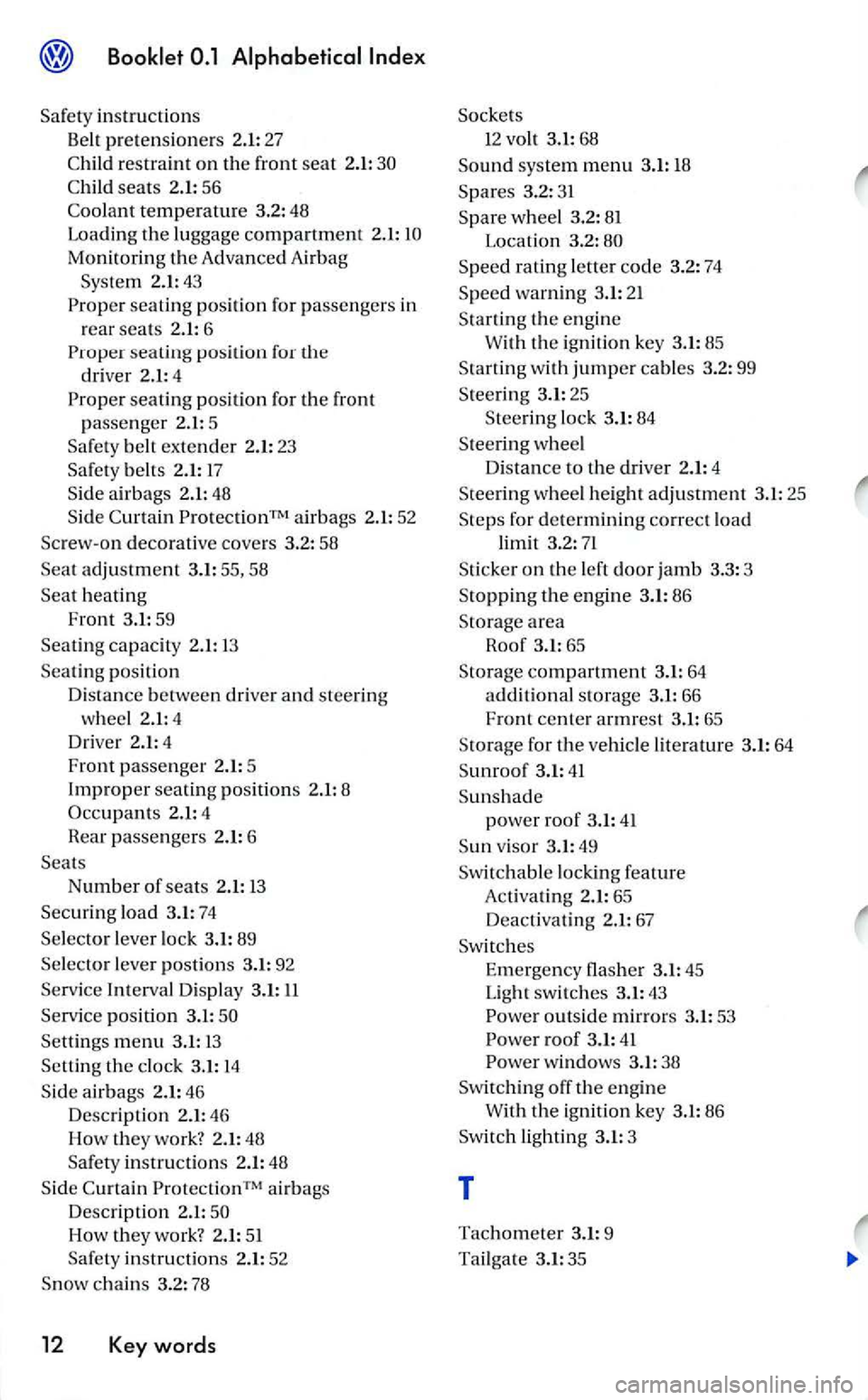
Safety instructions
Belt pretensioners 2.1: 27
Child restraint on the front seat 2.1:
Child seats 2.1 : 56
Coolant tempera ture 3.2:48
Loading
the lu ggage compartment 2.1:
seating position for passengers in
r
ear seat s 2.1: 6 seating position for
driver 2.1: 4
seating position for the front
passenger 2.1: 5
Safety belt extender 2.1: 23
Sa fet y
belts 2.1: 17 S id e airbag s 2.1: 48
Side Curtain ProtectionTM airbags 2.1: 52
Screw-on decorati ve covers 3.2: 58
Seat adjustment 3.1: 55, 58
Seat heating
Front 3.1:
59
Seating ca pacity 2.1: 13
Sea ting
position
Di s
tance between driver and ste erin g
w
hee l 2.1:4 Dr iver 2.1: 4
Fron t passen ger 2.1: 5 Improper seatin g position s 2.1: 8
Speed rating le tter code 3.2: 74
Speed warning 3.1: 21
Starting th e engine W ith the ig nition key 3.1:85
S tartin g
with jumper cables 3.2: 99
Stee rin g 3.1: 25
S
teering lock 3.1: 84
S te ering
wheel
Di s
tance to the driver 2.1: 4
Steerin g wheel height adjustment 3.1: 25
S
teps for determining co rrect load limit 3.2: 71
Sticker on th e left door jamb 3.3 : 3
Stopping the en gine 3.1:8 6
Sto rage
area
Roof 3.1:65
S torage
compartment 3.1: 64
additional sto rage 3.1: 66
Front center armrest 3.1: 65
S torage for
the vehicle literature 3.1: 64
Sunroof 3.1: 41
Sunshade
power roof 3.1:41
Sun viso r 3.1:49
Sw itch
able loc king feature
Activatin g 2.1: 65
D
eacti va tin g 2.1: 67
Sw itches Em ergency flasher 3.1: 45
Light swit ches 3.1: 43 outside mirrors 3.1: 53 ro of 3.1:41 windows 3.1: 38
Sw itching off the engin e
W ith the ignit ion key 3.1: 86
Sw itch
lig htin g 3.1: 3
T
Tachometer 3.1: 9
Ta
ilga te 3.1:35
Page 94 of 444
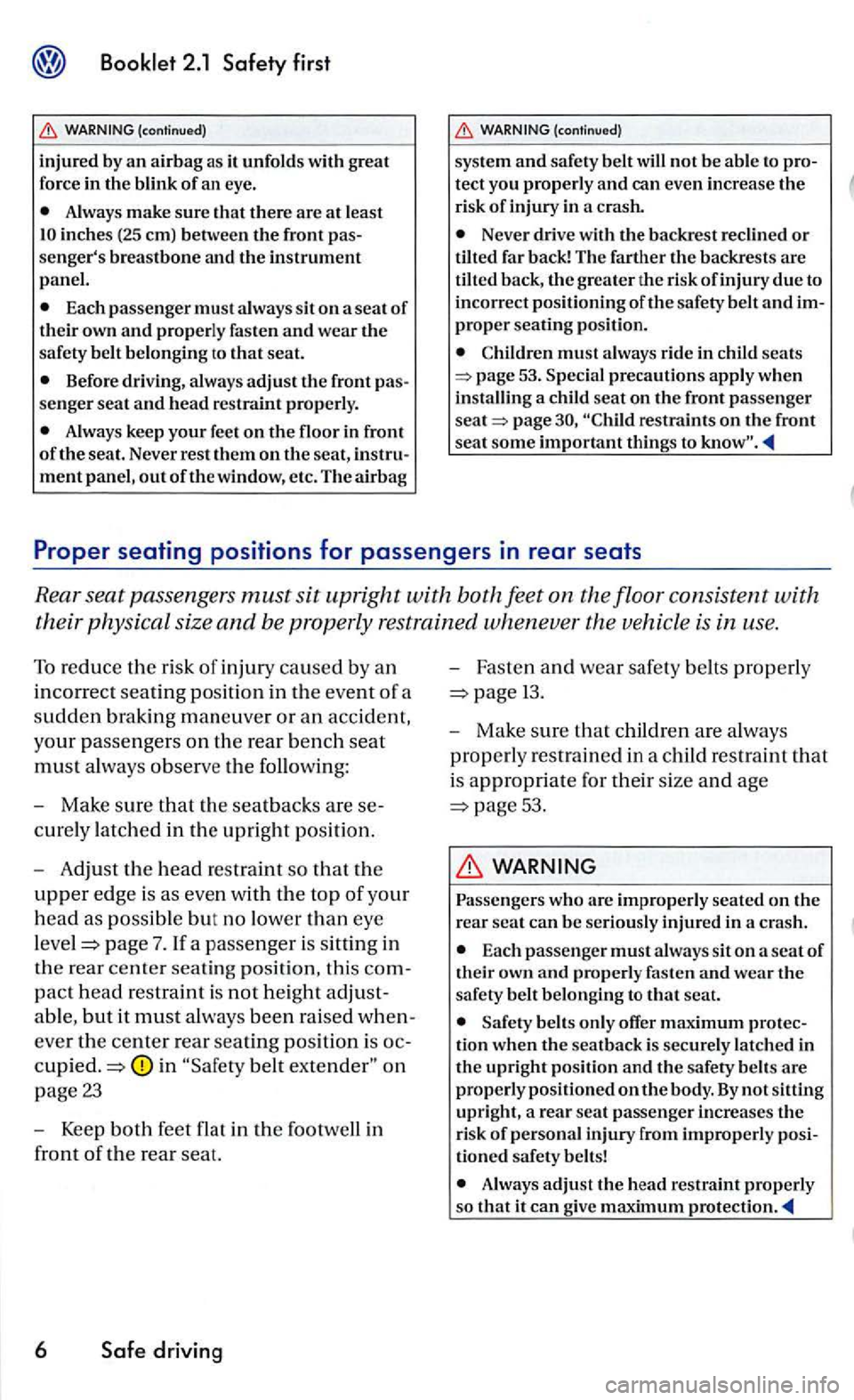
Always make sure that there are at least
Each passenger must always sit on a seat of their own and properly fasten and wear the safety belt be longing to that seat.
Before driving , always adjust the front senger seat and head re straint properly.
Alway s keep your feet on the floor in front of the seat. Never rest them on the seat, ment panel, out of the window, etc. The airbag
tect you properly and can even increa se th e
risk of injury in a crash.
Neve r drive with the backre st recl ined or tilted far back! The farth er the b ackrests are
tilted back, the greater the risk ofinjury due to
in correct positioning of the safety belt and
must always ride in seats 53. a child seat on the front passenger page
Mak e sure that the seatback s are
curel y lat ch ed in the upright position.
A djust th e head restraint so that the
upper edge is as even with the top of your
head as possible but no lower than eye
pag e 7. If a passe nger is s ittin g in
the rear center seating pos ition, this
pac t h ead restra int is not h eight
a ble , but it must always bee n rais ed
eve r the center rear seating posit ion is
belt on
page 23
Keep both feet flat in the footwell in
front
of the rear seat.
6 Safe driving
Fasten and wear safe ty belt s properly
13.
Make sure that children are always
prop e
rly restra in ed in a child re str aint that
is appropriate for thei r size and age
5 3 .
WARNING
Pas sengers who are improperly seated on the rear seat can be se riou sly injure d in a crash.
Each passen ge r must always sit on a seat of th eir own and properly fasten and wear the safety belt belonging to that seat.
belt s only offer maximum tion when the seat back is securely latched in
th e upright po siti on and the safety belts are
properly positioned on the body. By not sitting
upright , a re ar seat pass enger increases the risk of personal injury from improperl y
Always adjust the head restraint properly so that it can give maximum
Page 105 of 444
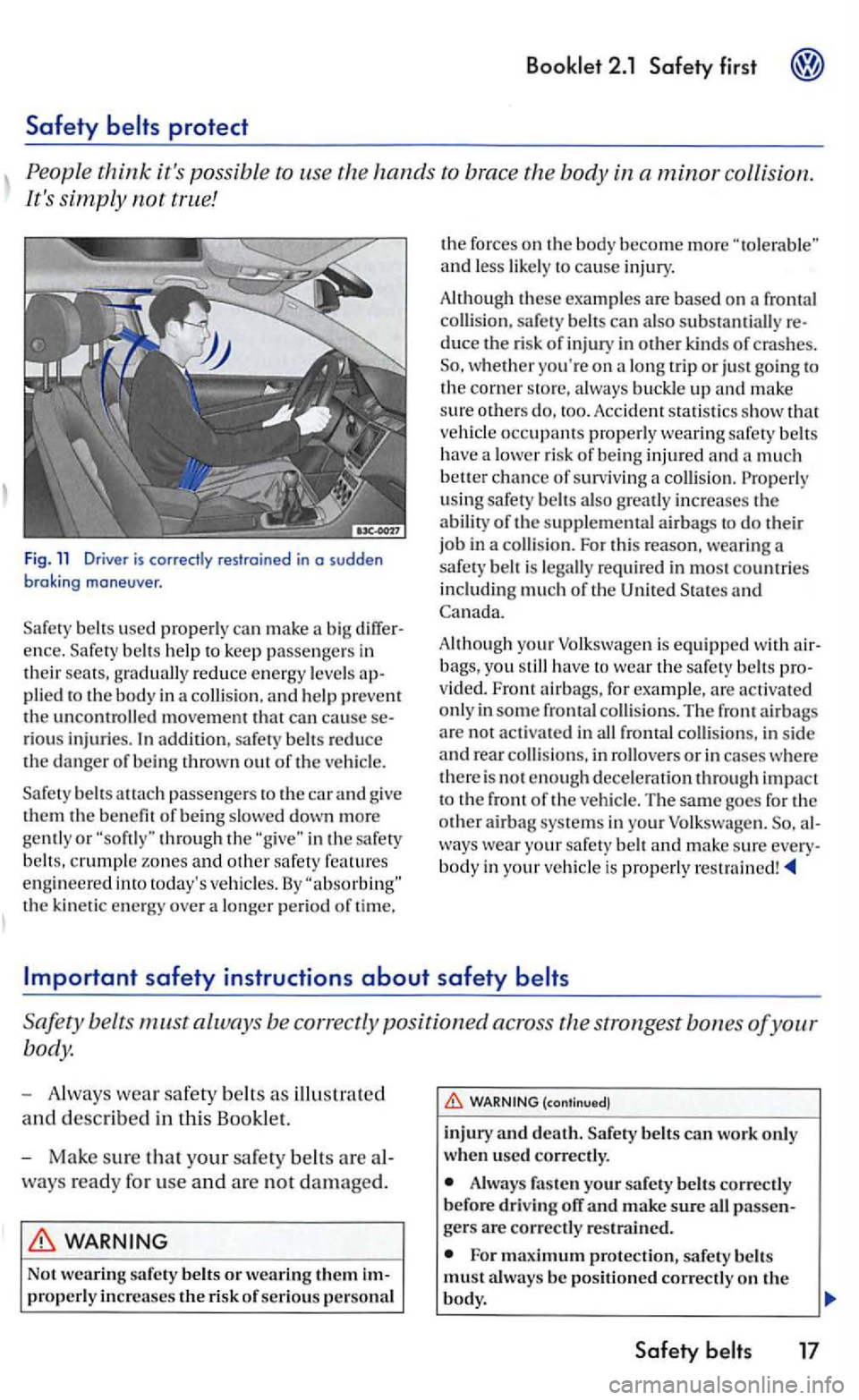
Booklet 2.1 Safety first
Safety
Fig . 11 Driver is correctly restrained in a sudden braking maneu ve r.
used properly can make a big differ
e n ce . help to kee p passenge rs in
t h ei r gradually red uce energy levels applied to the body in a collisio n. an d h elp prevent
t h e uncontrolled movement that can cause se
r ious injuries. additio n, safety reduce the danger of being throw n out of the vehicle.
passengers to the car and give them the benefi t o f being slowed down more ge ntly or t hroug h the c rumple zones and oth er sa fety features engineered today's vehicles. By
hough these examples are based on
Acci dent statist ics show that
veh icle occupants prop erly wearing safety have a lowe r risk of being i n ju red and
pro
v id ed . Fron t airbags, for example, are activated
only in some frontal collisions. The front airbags
are not activated in all frontal collision s, in side and rea r collisions, in rollovers or in cases where
there is not e n ough deceleration through impact
to the front of the ve hicle. The sa me goes for the
o ther airbag systems in your Volk sw age n. al
ways wear your saf ety
safety instructions about safety
Safety belts must always be correctly positioned across
Always wear safety belts as illu strate d
a
nd d esc ribed in thi s Book let.
WARNING
Not wearing safety belt s or w earin g them im
p ro perl y in cre ases the ri sk of serio us pe rso nal
Always fas te n your safety belt s correc tly
before driv ing off and make su re all passen gers are corr ec tly res traine d.
For m aximum protectio n, safe ty belts must a lways be pos itioned correctly on the
Safety belts 17
Page 118 of 444

page 53.
Eve n though your vehicl e is equipped wit h an Advanced Airbag System, make certain that all childre n , especially those 12 years and younger, a lways ride in the back seat properly restrained for their
if an infant up to about one year of age restrained in on e of the rearward-fac ing or forward-facing infant re
straints lis ted in Federal Mo tor Standard 208 with which the Advanced Airbag Sys te m in your was certified has been installed on the front passenger seat. For a listing of the child restraints that were used certify compli ance with the
55.
The PASSENGER
will stay on if the front passenger seat is not occupied,
will stay o n if the tot al weight o n the front passenger seat is that of a typical year-o ld infant restrain ed in one of th e rearward-facing or forward-fa cing infant restraints listed in
w ill go off if the front passenger seat is occupied by a n adult as re gis te red by the weightsen sin g page 40,
can stay on if the weight on the seat is more than th e typical! year-o ld infant re-
strained i n one of the child restraints li sted in 208 but less than weigh t of a small
the total weigh t on the front passenger seat is more tha n that of a typica l
208, the front airbag on the passenger side can deploy (the PASSENGER
light does not come on) even if the weight is less than the weight of a small adult. I f the PASSENGER light does not come o n, th e front airbag o n the passenger side has not been turned off by th e e lectronic control unit and can deploy if the control unit senses an impact that meets the conditions stored in its
memory.
For example, the airbag may deploy if:
a small chil d that is heavie r than a typical year-old infant is on the front passenger seat restrained in one of the c hild seats liste d in 20 8 page 55 or
a child who has outgrown child restraints is on the front passenger seat.
If the front passenger airbag is turned off, the PASSENGER and sta ys on.
The front airbag on the passenger sid e w ill deplo y if the PASSENGER BAG lig ht does not come on and sta y on even if a small or teenager, or passenger who is not sitting up
right w ith their back against a non-recl in ed bac kre st with th eir feet on the in
front of the seat i s on the
deployment occurs in those crashes that ta ke place at lowe r decelera ti o ns as defined in
Page 119 of 444
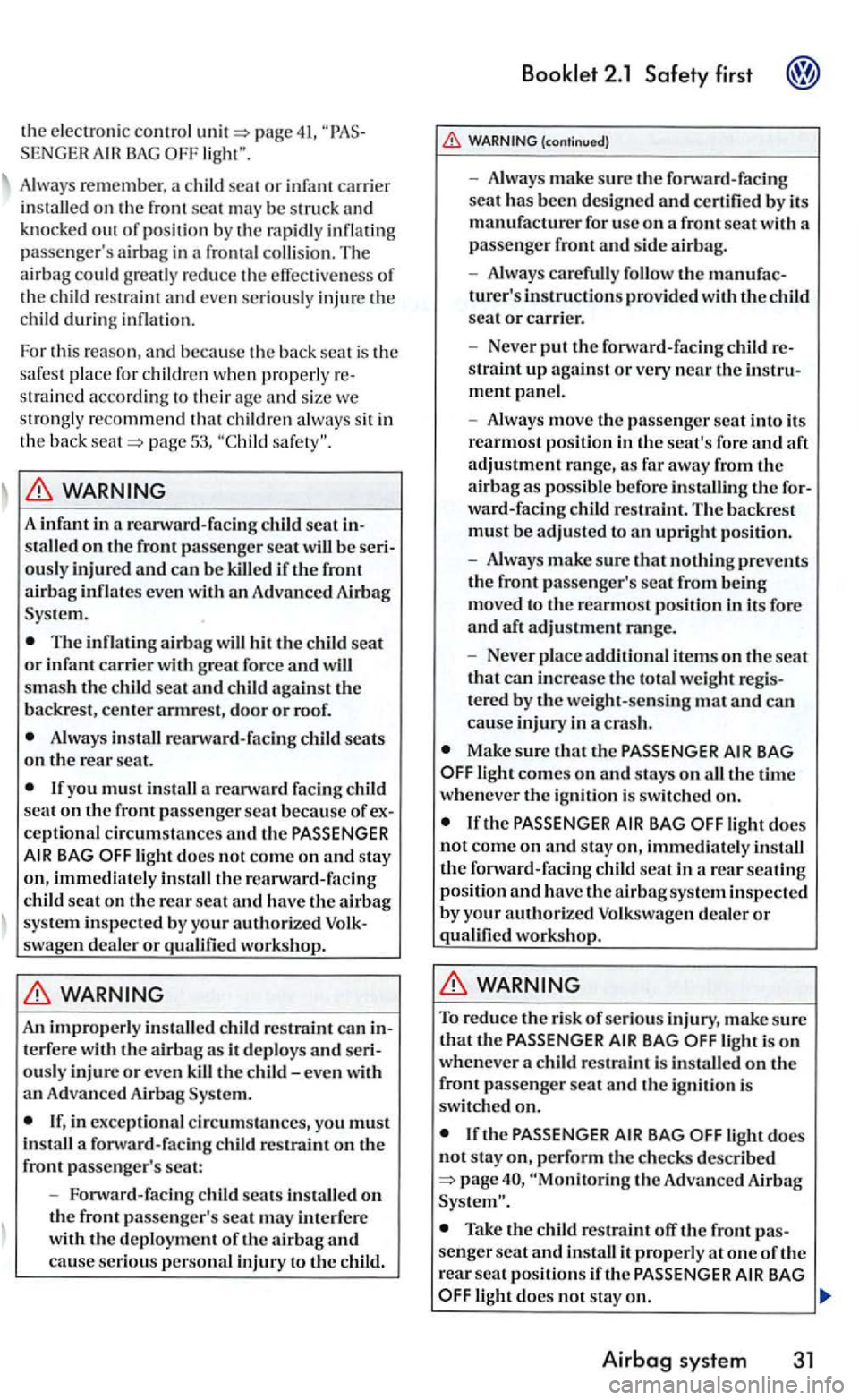
the elec tronic control page 41, SENGER
Always remember. a child seat or infa nt carrier
in stalled on th e fron t seat may the rapidly pas senger's airbag in a frontal collision. The
airbag could greatly re duce the effectiveness of the c hild restraint and even seriou sly injure th e
c hild during
stro ng ly recommend that children always sit in
th e back page 53,
infant in a seat stall ed on th e front passe nge r seat ously injured and can be killed if the front
airbag inflates eve n with an
System.
The inflating airba g will hit the child seat or infant carrier with great force and will
smas h th e c hild seat and c hild against the backrest, cent e r armre st, door or roof.
Always install r earwa rd-facing child seats on the rear scat.
If you must install a rearward facing child seat on the front passe nger scat becau se of
light docs not com e on and stay on, imme diatel y
your authorized swage n dealer or qualified workshop.
terferc with the ously inju re or even the child -eve n with
a n A irb ag
in exceptio nal circumstances, you must
in stall a fonvard-facing c hild restraint on the front passe nger's sca t:
-
Fon vard-facin g seats install ed on the front passenger's seat may interfer e
with the deplo ym ent of the air bag and cause seriou s personal injury to the child .
2.1 Safety first
turer's instructions provid ed with the c hild
sea t or carrier.
- Neve r
put the fonvard-faci ng c hild
ment panel.
- Always move the passe nge r sca t into its
rearmost pos ition in the scat's fore and aft adjustment range, as far away from the airbag as possi ble before installing ward-facing
scat that can increase the total weight te re d by the weig ht-sensing mat and ca n
ca use injury in a cras h.
Make sure that the BAG light comes on and stays on all the time w henever the igniti on i s switc hed on.
th e BAG light does not com e on and stay on , imm ediately in stall the fonv ard-facing child scat in a rea r seatin g
position and have the airba g sys tem inspec ted
by your authorized Volkswagen dealer or qualified workshop.
To reduce the ris k of se rious injury, make su re that tltc light is on whenever a child restraint is install ed on th e
front passenger scat and the ig niti on is switched on.
the d ocs not stay on, perform th e c hecks descr ibed the Advanc ed
Take the c hild restra int off the front senger seat and in stall it properly at one of the
r ear sea t position s if th e BAG light does not sta y on.
Airbag system 31
Page 121 of 444
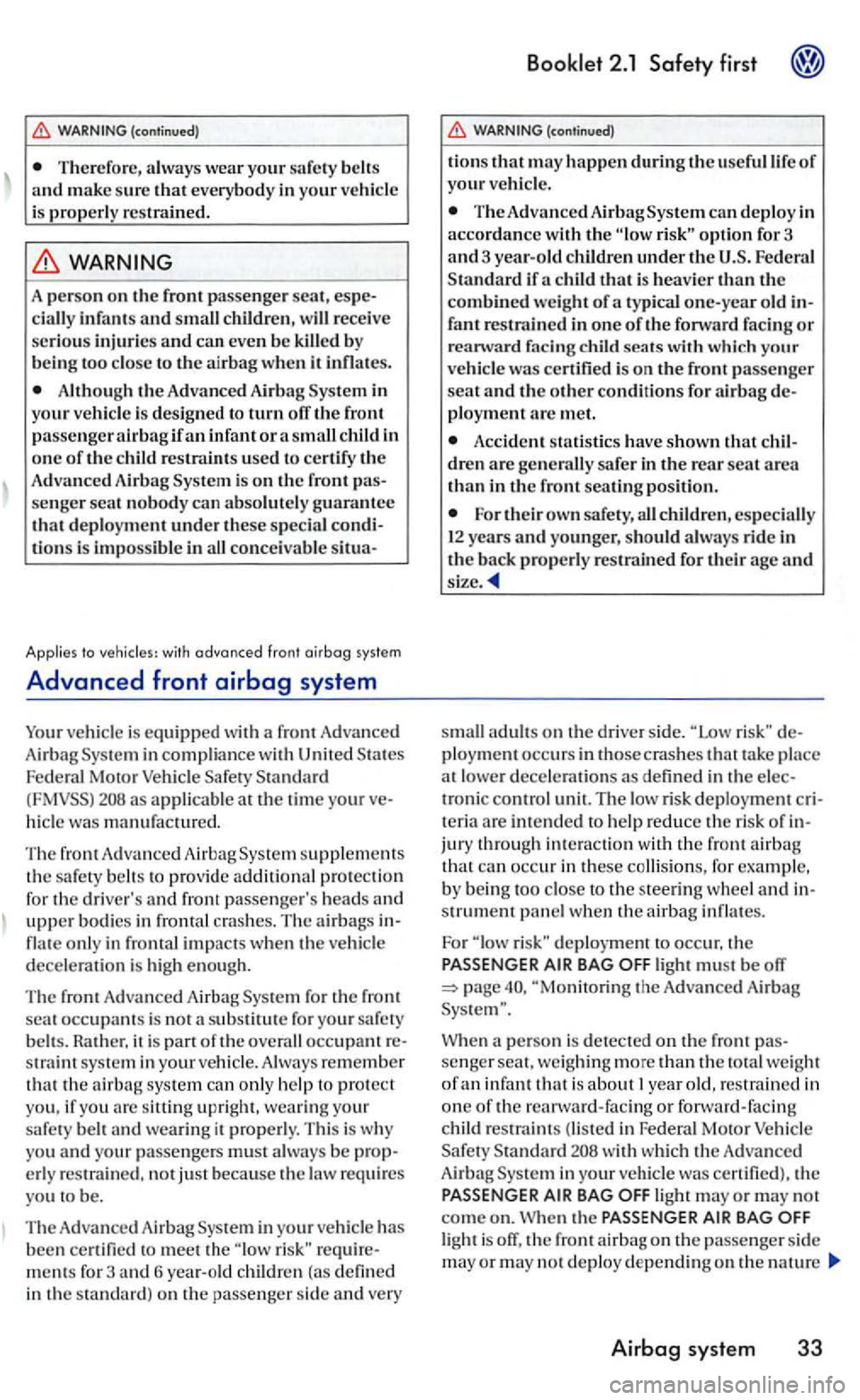
Therefore, always wear your safety belts and make sure that everybody in your vehicl e
i s properly re strained.
A person o n the front passenger seat, cially infants and small
Although the Advanced Airbag System in your vehicle is designed to turn orr the front passenger airbag if an in fant or a small child in one of the child restraints used to certify the Advanced Airbag System is on the front
tion s is impossible in all conceivabl e situa-
Applies to vehicles: with advanced front airbag system
Advanced front airbag system
Your vehicl e is equipped with a front Advanced
A irbag System in complia nce with States Federal Motor Vehicle Safety Standard as applicable the time your hicle was manufactured.
The front Advanced AirbagSystem supplemems the s afety belt s to provide additional protection
for the driver's and front passenge r' s head s and upper bodi es in frontal crashes. The airbags
straint system in your vehicle. Always remember that the a irba g system can only help to protect if you are sittin g upright, wearin g your safe ty belt and wearing it properly. This is why
yo u and your passengers must always be erly restrained, not just because the law requi res you to be.
The Adva nced Airbag System in yo ur ve hicl e has been to meet the ment s for 3 and 6 yea r-old childr en (as defined
in the s tandard) on the passenger sid e and very
The Advanced AirbagSyste m can deploy in accordance with the
fant restrained in one of the fonvard facing or rearward facing child seats wit h which
plo yment arc met.
Accident statistic s have shown that
For their own safety, all children, especially 12 years and younger, should always ride in the back properly restrained for their age and
small adult s on the driver side. ployment occurs in those crashes th at tak e place
troni c control unit. The low risk deployment teria are intended to help reduce the ris k of jury through interact ion with th e front airbag
t hat can occur in these collisions, for example.
b y
being too close to the steering wheel and
deplo yme nt to occur. the PASSENGER light mus t be orr "Monito ring the Advanced Airbag
year old. restrained in one of the rearward-facing or forward-facing
child restraims (listed in Federal Motor Vehicle Safety Standard with which the Advanced
A irbag System in yo ur veh icle was the PASSENGER BAG light mayor may not come on. Wh en the PASSENGER light is off, the fron t airbag on the passe nge r side may or may not deploy depending o n the nature
Airbog system 33
Page 122 of 444
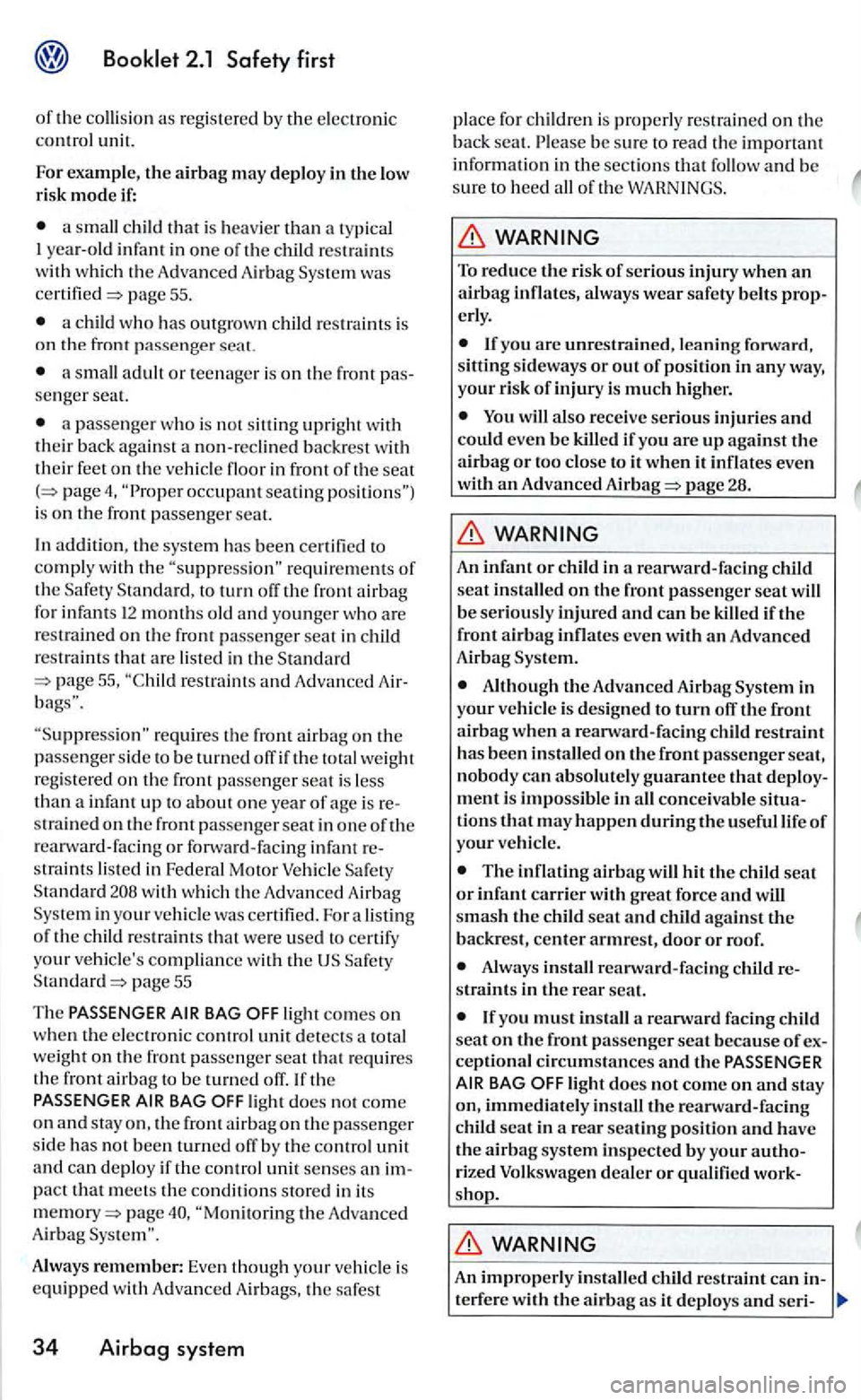
a small child that is heavier than a typica l
I ye ar-old infant in one o f th e child restraint s
w ith whi ch th e A dvan ced Airbag was page 55.
a child who has outgrown child res traints is
o n
a small adult or te enage r is on th e front se nger seat.
a passe nge r w ho is not sitting upright with
thei r back against a non -re clined backr est with
th eir feet on th e ve hicl e floor in front of the seat occupant seatin g is on t h e fr o nt passenger seat.
re quir em ent s of th e to turn off the fron t a irb ag
f o r infant s 12 months old and younger w ho are
re strained on the fro nt passenger seat in ch ild
restraint s that are liste d in the Standard re str aint s and Adva nce d
requires the front airb ag on th e passenge r sid e to be turned off if th e tota l weig ht
r eg is tered on th e front passe nger is less
th an a inf ant up to about one year of age is s tra ined on the front passe nger seat in one of the rea rward-faci ng or for wa rd-fa cin g inf ant str aint s listed in Fed eral Moto r Vehicle
page 55
The BAG
light does no t come o n and stay on . th e front airbag on the passen ge r
s id e has not been turned off by th e co ntrol u nit and can deploy if th e control unit se nses an pact that meets th e co nditio ns s tored in its page
Alwa ys remember: Even thoug h yo ur veh icle is equipp ed with Adva nced Airb ags, the sa fest
34 Airbag system
pla ce fo r childr en i s properl y restrained on th e back seat. b e sure to read the important
information in the sections tl1at follo w and be
sure to heed all of th e WARNINGS.
To reduce th e risk of serious injury when an airbag inflates , always wear safety belts erly .
You will also receive serious injuries and could even be killed if you are up against the airbag or too close to it when it infl ates eve n
with an Advance d Airbag
An infant or child in a rearward-facing child
seat installed on the fron t passenger seat will be seriously injure d and can be killed if th e
front airbag inflate s eve n with an Advanc ed
Airbag System.
Although
ment is impossibl e in all conce ivab le tions that may happen during th e usefu l lif e of your ve hicle.
The infl atin g airbag hit the child seat or infant ca rrier with great force and will
s m as h th e child seat and child against backres t, center armrest, door or roof.
straint s in the rear seat.
front passe nge r scat because of ceptional circumstances and the
sh op.
terfer e with the airbag as it deploys and seri -
Page 125 of 444
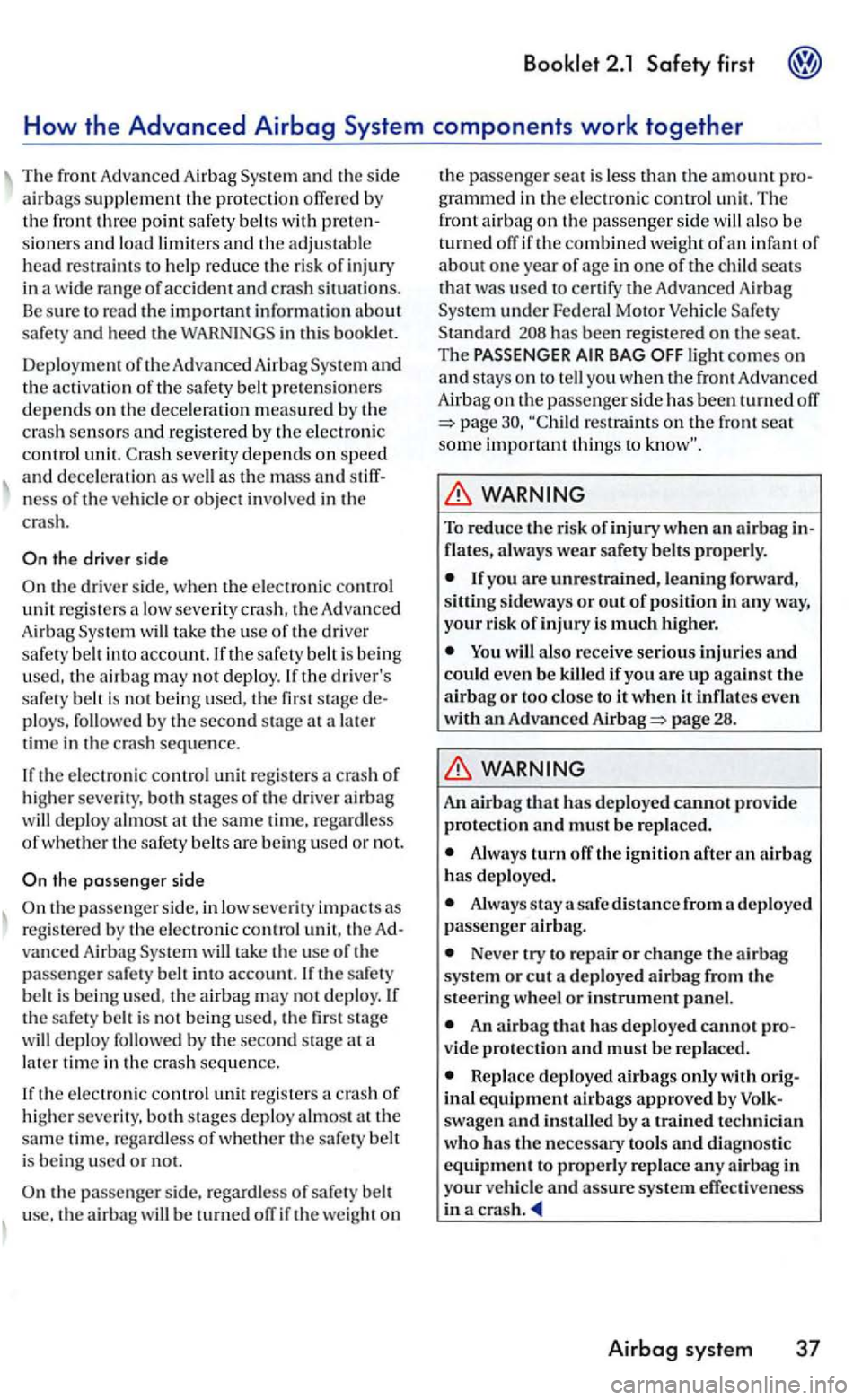
severity de pends on sp eed and d ece lemtion as well as the mass and n ess of the vehicle or object involved in the
cras h.
plo ys. follo wed by the second stage at a lat er
t im e in the cras h sequence.
If t
he ele ctronic co ntrol unit regis ters a cras h of
high e r seve rity, both stages of th e drive r a irbag will d eplo y almost at the same time, rega rd less of w he th er th e safe ty belts are bein g used or not.
gramm ed in the e lec tron ic co ntrol unit. The front airba g on the passenger side will also be
turned off if th e combined weight of a n infant of about one year of age in one of th e child seats
that wa s use d t o ce rtify the Advanced Airbag Sys te m under Federa l Moto r Vehicle Safety
S tandard has bee n regi ste re d on th e seat. The
res traint s on the front seat some important things to
flat es, always wear s afety belt s properly.
If yo u are unres trained , leaning forward,
s itting sideways or out of position in any way, your risk of injury is much higher.
28.
An airbag that has deplo yed cannot provide protecti o n and must be replac ed.
Alway s turn off the ignition after an airbag has deployed.
safe distance from d eplo yed passenge r airbag.
N ever try to repair or change the airbag s ys te m or c ut a deployed airbag from the
s teering wheel or in strument panel.
An airbag th at h as deployed cannot vid e protection and must be re placed.
Repla ce deployed airbags only with ina.l equipment airbags approved by swagen and in sta ll ed by a train ed t echnician who has the necessa ry tools and diagno sti c equipment to properly replace any airbag in
your ve hicle and assu re syste m effectiveness in a cra sh
Airbag system 37